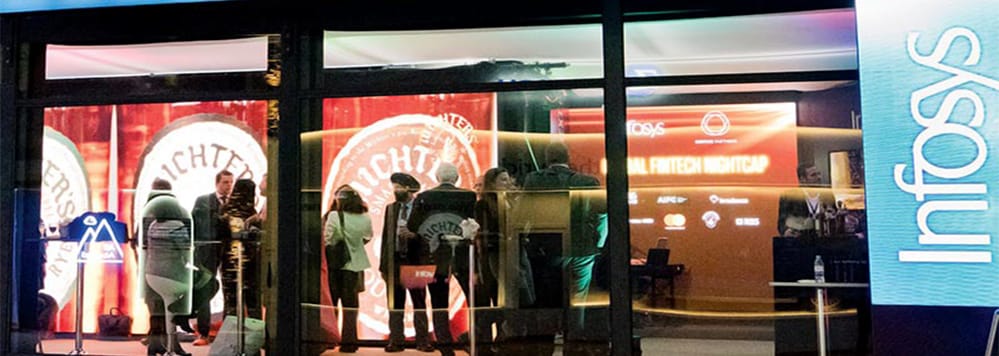A Note from the CEO
Salil Parekh
Chief Executive Officer and Managing Director
Reflecting back on my time in Davos at the 2019 World Economic Forum, I am amazed at the profound level of transformation that has occurred over the past year. The pace and magnitude of the current technology-driven changes are unprecedented.
We are standing on the threshold of history, looking at a world that is rapidly digitizing. Opportunities are tremendous in a world where our learning capabilities, both human and machine, grow exponentially with each day.
As the digital revolution continues to re-shape our economic landscape, it’s become more important than ever for industry leaders, policy makers and academics to have an open forum in which to discuss these transformations and the impact they’re having around the world.
In the Infosys Pavilion at WEF 2019, we were honored to host panels on everything from digital disruption and artificial intelligence to workforce automation and the platform economy. We kicked off the week with a session that explored the current state of digital transformation. During this discussion, I had the honor of sharing the findings of our freshly-released Digital Radar Report. Written and published through the newly-formed Infosys Knowledge Institute, this report provides a detailed assessment of the barriers and accelerators of the digital transformation journey. The rest of the panels continued that duality of technology potential and human amplification.
The thought leadership on display during these panels was further validation that Infosys is guiding strategic discussions that will assist companies to succeed in the digital economy. The ramifications of the topics discussed will impact companies, governments and individuals alike. This level of dialogue is why I have always treasured my interactions at the World Economic Forum. These conversations are both intellectually stimulating and action-oriented. After Davos, I’m more confident than ever that we can bring our promise to navigate your next to each of our clients, and offer the market a strategic and much-needed perspective.
WEF 2019 was an enormous success thanks to the efforts of many Infoscions and our wonderful panelists. We proudly present these summaries and findings from our WEF 2019 panels to you. May these insights serve as a guide on your own digital transformation journey.
Where Does the Digital Radar Point?
Digital transformation is important for all businesses, and an existential issue for those in a growing number of industries throughout the world. However, it’s also an issue that is so nuanced and sophisticated that it often presents more questions than answers. How exactly should companies identify and deliver transformative change in these increasingly disruptive times?
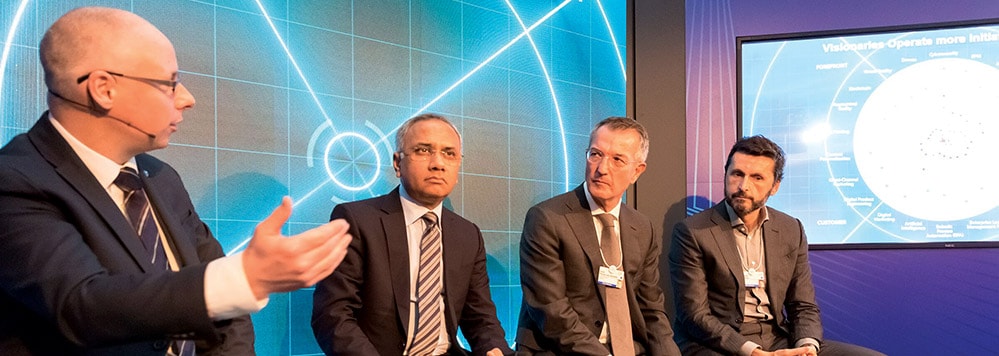
On the morning of January 22, moderator Derek O’Halloran, head, Future of Digital Economy and Society for the World Economic Forum (WEF), kicked off the first WEF panel in the Infosys Pavilion with a discussion of digital transformation and how companies are currently aligned along the digital spectrum.
Salil Parekh, CEO and managing director, Infosys; Hans Ploos van Amstel, CFO, Adecco Group; and Miguel Milano, president EMEA, Salesforce, took a measured but optimistic approach to addressing these topics and questions. The insights they provided are grounded in the latest research as well as their decades of experience leading three of the most digitally adaptive companies in the world.
Visionaries, Explorers, and Watchers
Parekh opened the conversation by introducing the findings from the recently released Infosys Digital Radar 2019 report. In 2018, Infosys surveyed more than 1,000 executives working in large organizations around the world with more than 5,000 employees and $1 billion in annual revenue. The survey showed that incumbent companies fall into one of three categories, determined by their progress along the digital transformation journey: watchers, explorers, and visionaries.
According to the report, watchers are companies that still see technology primarily as an enabler of efficiency. They have deployed some digital initiatives, but are more focused on traditional business matters such as cutting costs and increasing productivity rather than looking at ways to digitally differentiate themselves from their competitors. Explorers are companies that have expressed a deep level of interest in the new digital capabilities that are available, but have not yet used those capabilities to fully transform their business models. Visionaries are the companies that have boldly embraced all the opportunities that these new digital technologies offer. They utilize these technologies to accelerate growth by transforming both their cultures and their business models.
“Visionaries are related to a comprehensive change of their business, while watchers focused more on some single elements of change,” Parekh said. “Explorers really focused on the experience element, which is the first element most companies have been driving.”
The research showed that companies are able to move from the watcher to the explorer level without extreme enterprise-wide effort or risk. However, the effort needed to move from being an explorer to a visionary is exponentially greater and involves a much higher level of dedication that spans the entire organization. The lack of nimbleness due to the burden of legacy technology and the lack of available skills are two of the biggest obstacles that explorers face on their journey to becoming visionaries, Parekh said.
Milano, who runs all operations for Salesforce in Europe, the Middle East, and Asia, said that his company recently completed a similar research study and that the results mirror those from the Infosys report. Salesforce took a sample of 500 companies and reviewed how they were utilizing the capabilities of the Salesforce software to transform their businesses.
The participants fell into three categories, or “mind-sets,” that Salesforce called renovate, evolve, and transcend. While the renovate mind-set is somewhat more sophisticated than the watchers from the Infosys study, the evolve and transcend companies line up almost perfectly with the characteristics of the explorers and visionaries from the Infosys report, Milano said.
One example of an industry that’s embracing the transcend or visionary mind-set is the telecommunications industry, Milano said. These companies have realized that their future lies not in providing traditional telco services, but in the power of the data they’ve accumulated over the years. They have data on location, total spend, usage during certain times of the day, and more. They’re partnering with their users to develop new business models related to that data that will completely transform the whole industry, he said.
“I wouldn’t be surprised if in ten to twenty years 80 percent of the business of a telco is about using, exploiting, and monetizing the data of its customers,” Milano said.
Ploos van Amstel, who is in the unique position of leading his company’s digital transformation efforts from the position of CFO, agreed that it’s vital for companies to partner with their customers throughout the transformation process to ensure the new technology is a positive experience for them.
He said that Adecco’s GrowTogether program did a thorough psychometric analysis of its entire customer experience, which gave the company the insights it needed to know where to play and how to win when making technology decisions in the future.
“We replicated that deep insight of what we know much better than anybody can replicate. It’s that institutional knowledge,” Ploos van Amstel said. “And that’s what companies today need to do. They need to really understand how they add value and what new business models should do.”
Reskilling the Workforce
A secondary theme that emerged as an accelerator of the journey from an explorer to a visionary was the question of skills. As technology continues to progress, it’s obvious that the workforce of tomorrow will require skills they simply don’t have right now. New opportunities for both companies and individuals are emerging every day, and it’s critical that leaders get their workforces ready for it, Ploos van Amstel said.
Adecco Group is the world’s largest staffing firm, and it puts 350,000 people who have been laid off into new jobs each year, he said. With the current churn of technology, that workforce turnover level won’t be sustainable in the future because the cost to society is too high.
University degrees are no longer required to do certain jobs. It’s possible to take truck drivers and factory workers and teach them how to code. If you reskill and retool properly, it benefits everybody, Ploos van Amstel said. The company receives higher productivity, and the employee now has the skills required for a higher salary.
“Reskilling makes sure you get your workforce the opportunity to work with the technology of tomorrow,” he said. “If we don’t do it, it becomes a societal issue, because you can’t say you get your pension at 70, but then say at 50, we don’t need you anymore.” Milano added that the obligation of reskilling people is going to inevitably fall on companies, because the government-run school systems across the globe just can’t keep up with the technological trends of today.
Schools didn’t teach many things that people are working on today, Milano said. In his estimation, the educational system is roughly fifty years behind where it needs to be, but since most education is run by the government, they have no incentive to try to change at the same rate that the world is changing.
Ploos van Amstel and Milano agreed that companies that take this obligation seriously and demonstrate they are driven by purpose will be the winners in the new economy. By being willing partners with the government, businesses can be at the forefront of providing people with the skills needed for the workforce of tomorrow. When you create a better world, you create better business, Ploos van Amstel said.
Parekh closed the discussion by pointing to the Infosys foundations in both India and the U.S. that are dedicated to engaging with schools in both countries to teach valuable STEM skills to high school students. These activities are funded by a percentage of the Infosys profits that leadership sets aside each year for philanthropic reasons.
“It was good to see in many ways, even as we come from different perspectives, that we have a similar view of what the market is doing,” Parekh said. “We believe that change is quite dramatic, and the ones who adopt and build upon the change are going to greatly benefit from it. They’re going to leave the others way behind in terms of how they compete.”
Future of Artificial Intelligence: Driving Purpose and Profitable Growth
Driven by a massive increase in data, soaring computational power at shrinking costs, and breakthroughs in technology, artificial intelligence is now a commercial reality. As a productivity enhancer, it is augmenting human labor and physical capital, optimizing processes with intelligent automation systems, and propelling new innovations. But perhaps even more importantly, if AI can take over the repetitive work that most people disdain, their new roles could include finding new ways to contribute to the higher purpose of their companies.
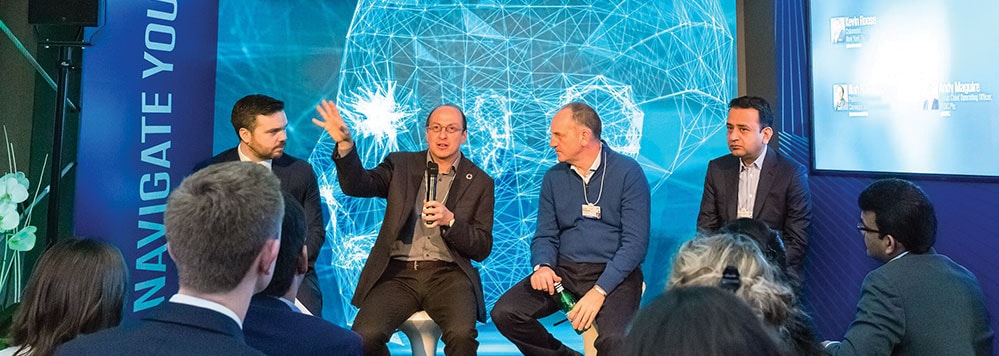
In this panel held on January 24, New York Times columnist Kevin Roose moderated a discussion on how businesses can act now to develop strategies for AI that put people at the center.
Mohit Joshi, president, Infosys; Andy Maguire, group COO, HSBC; and Illah Narbaksh, professor of robotics, Carnegie Mellon University, offered insights into how companies can commit to developing responsible AI systems that are aligned to drive positive outcomes that empower people to do what they do best—imagine, create, and move the world forward.
AI’s Impact on the Workforce of Tomorrow
Roose opened the conversation by paraphrasing famous Silicon Valley venture capitalist Marc Andreessen, saying, “In the future, there will be two types of people–people who tell computers what to do, and people who are told by computers what to do.”
This quote strikes at the heart of a lot of the concerns related to AI, Roose said. Much of the consternation and hand-wringing among the greater population related to AI has to deal with the perceived notion that computers will eventually make a huge number of jobs obsolete.
When asked whether he thought Andreessen’s quote was accurate, Mohit Joshi said it’s true, because it’s already happening. But there is also a third type, the people who will be amplified by computers to do amazing things. The power of AI and automation is something that’s already incorporated into much of our everyday lives, even if we’re unaware of it. For the most part, it’s had a positive effect.
“If you look at AI and computers as prediction machines, as things that are able to take a huge amount of data and then make quick decisions based on that, to a very large degree, it’s already true,” he said. “Now, I don’t think that robs people of their essential humanity.”
Joshi pointed to the fact that factories and manufacturers have used enterprise software for more than 30 years to help determine their staffing levels and the times when those people are needed. “Computers have already been telling people for 30 years when they should show up to work or if they should show up for work. I don’t think AI changes that very fundamentally,” he said.
Andy Maguire echoed Joshi’s optimism related to AI’s impact on the workforce, adding that a lot of the theories surrounding AI are mostly hyperbole. “I don’t think it’ll revolutionize the workplace in the way people are scared about,” he said.
In large-scale organizations like HSBC or J. P. Morgan, AI focus is very narrow but also very deep, he said. These companies have hundreds of thousands of employees, and oftentimes, AI impacts less than 1 percent of them. In HSBC’s branches and call centers, there are large-scale digitization efforts happening, but they don’t eliminate the need for people in those areas altogether, Maguire said. It often frees those employees from work that is mostly mundane and repetitive, allowing them to focus more on judgment-based projects and work that involves critical thinking.
“If we educate people to do the things we need them to do tomorrow and in the next decade, I think it’s all going to be OK, actually,” he said.
Joshi added there are also a lot of misconceptions regarding how quickly large-scale AI transformation is going to take place. While it’s true that AI is already being integrated into companies of all sizes, we’re still at least 15 to 20 years away from AI being the heart of a major corporation and making a lot of the decisions that senior executives make now, he said. In the meantime, AI is helping to alleviate a lot of the drudgery work in fields like financial services, freeing people from tortuous 100+ hour workweeks.
The Ethics of AI
Despite the generally optimistic framing of how AI is currently utilized, there is still a large potential for it to be abused. Roose turned to Illah Narbaksh, who is developing a unique educational approach at Carnegie Mellon to ensure that the engineers of tomorrow implement AI in the most ethical way possible.
Narbaksh said his team looked at the recent Cambridge Analytica scandal and asked themselves the question, “What can we do to ensure that we don’t actually cause another one of those?” They found their answer in a field of study that is often overlooked by students who have focused their entire education solely on technology: the humanities. By overlooking the humanities, these students come into their chosen fields with no sense of historical context, Narbaksh said.
“You realize you have a whole gang of people who can invent the world, they can bend the arc of the future, and they have no historical context. They don’t even know what the concept of power negotiation means,” he said.
In order to address this issue, Narbaksh worked with his Carnegie Mellon colleagues to reimagine the required freshman-level English course to be more focused on the humanities as a whole and the ethical implications of AI. During the new course, which is called AI and Humanity, the students are exposed to deep philosophical themes related to equity, fairness, and the power of technology to shape the future. They use concept diagramming to look at the possible trajectories for how they can invent the future and how they can do so in the most equitable and fair way possible. After taking the class, the students are better prepared to discuss the realistic implications of the technology they create and the impact it will have on society instead of just being glaringly “techno-optimistic,” as Narbaksh put it. It allows them to understand that not all of our problems are going to be solved with AI and technological innovation alone. It requires an equal level of social innovation as well, he said.
The AI and Humanity course is being translated and presented as a textbook so that universities and technical schools all across the world can incorporate the class into their programs.
Focus on the Soft Skills
Understanding the ethics and social responsibility component of AI provides a strong foundation for the technologists and engineers who are shaping the future of computing. Logic would dictate that the other skills companies are looking for in these professionals would revolve around machine learning, advanced computing, and other hard sciences. However, Roose mentioned a recent LinkedIn survey that polled a large sample of hiring managers in the technology sector, asking which skills they were looking for the most. The results showed that instead of looking for skills that are strictly rooted in technology, companies are seeking individuals who possess strong “soft skills.” These include creativity, persuasion, and collaboration.
Joshi said that he sees this same trend playing out at Infosys, which has more than 205,000 employees and hires thousands of new engineers and computer scientists every year. The most important skill that Infosys looks for in all new employees is “learnability,” he said.
“As cycles become faster and faster, you need to learn every year, you need to learn every month and almost every day. So the one most important thing we hire for is learnability – people who are curious, and people who are creative, self-driven, and want to learn,” Joshi said.
To illustrate his point, Joshi pointed to the level of demand he’s seen within Infosys for continued education. The company released a comprehensive education platform within the past year with the hope that employees would spend 20 minutes a day on it. It turns out that employees are engaging with the platform more than 30 minutes each day and an hour on the weekends, he said.
“It’s not like we have to push them to learn new stuff; they’re pushing us, which is a very positive sign,” Joshi said. This positive comment was a fitting close to the discussion. Learnability and lifelong skills development will go a long way to helping the AI revolution drive purpose and amplify human potential, while seeking profitable growth.
Thriving in the Time of Digital Disruption
It goes without saying that digital disruption is one of the central issues of our time. And as the digital landscape continues to evolve, it’s quite clear there are going to be winners and losers. It’s an issue that everyone has to confront—companies, investors, advisers, policymakers, and individuals.
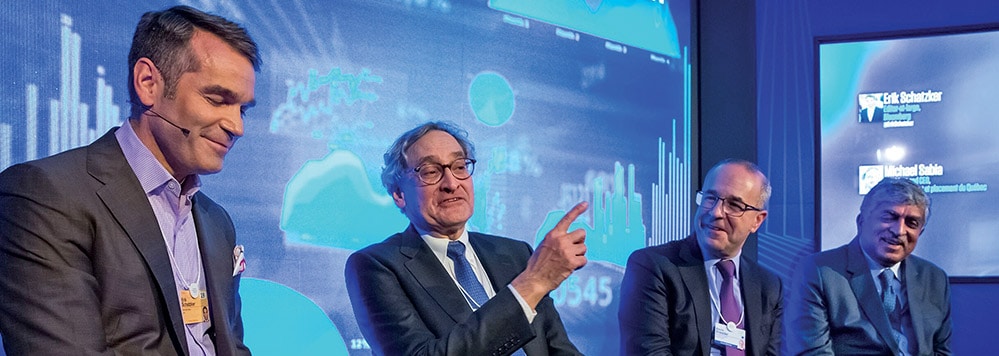
In a session held on January 23, moderator Erik Schatzker, editor-at-large for Bloomberg TV, led a discussion on digital disruption and how the ever-increasing scope of technological innovation will shape the futures of both corporations and governments over the next decade.
How exactly will digital disruption play out? Which technologies will be the most transformative? And what changes will they leave in their wake?
A panel featuring Nandan M. Nilekani, chairman, Infosys; Michael Sabia, president and CEO, Caisse de dépôt du Québec; and Kevin Sneader, global managing partner, McKinsey & Company, offered up expert insights on the technologies that will be the most impactful and what the implications will be for incumbents as they prepare for these changes.
How Will Digital Disruption Play Out?
Nilekani led off the discussion by stating there are a large number of technologies that will be impactful over the next decade. Just as the previous ten years saw the proliferation of the smartphone to more than three-and-a-half billion people, Nilekani said, the next decade will see that level of technology integrated into tens of billions of new devices that surround every aspect of work and home life. Every automobile, factory, and mine will have elements of smart technology built into them. And as this transition occurs, the massive amount of data being created will inevitably lead to a huge increase in the use of artificial intelligence and machine learning.
This unprecedented level of deep machine learning has the potential to cause the cost of prediction within businesses to plummet, Nilekani said. In a world where the cost to accurately predict waste approaches zero, businesses will realize significant impact, on a very large scale.
Nilekani believes the automotive industry is especially vulnerable to the effects of digital disruption. Technology is already on the cusp of moving the industry away from gas-powered to electric and hybrid cars. Autonomous or semiautonomous cars are now on the horizon, and ride sharing has the ability to move societies from the mind-set of individual ownership to fleets.
Incumbent companies in the automotive industry and beyond face substantial risk as everything continues to become more and more “software-ized,” as Nilekani put it. New companies running completely on software models can deliver capability at a fraction of the cost that slow-moving incumbents and their legacy systems can provide. The need for this shift will also create enormous opportunities for those who embrace the change.
“The past decade has been the decade of the consumer,” Nilekani said. “I believe the next ten years are going to be back to the enterprise, because getting all the businesses in the world to be ready for the new world is really going to be the big growth of the next ten years.”
Sneader agreed with Nilekani that the next year will be focused on industry, but he said that eventually digital disruption is going to impact individuals the most over the next decade, particularly in three areas: how they make decisions, how they live, and how they operate at work.
The decision-making process, and ultimately the entire way leaders think, will have to change due to the sheer volume of data that will be available. All decisions will need to be informed through analytics and through a way of thinking that is grounded in fact, Sneader said.
“We can decide whether we like that world or not, but I think that is a world that is out there for us, and you can see it with some of the more sophisticated applications that are already being put in place to support decision making,” he said.
In terms of living and operating at work, Sneader foresees the internet of things revolutionizing how people interact with their own homes and jobs. As smart technology evolves, it has the potential to change a lot of the everyday tasks that people currently undertake at home. At an operating level, the digitizing of factories and manufacturing as a whole will lead to new employment opportunities or challenges, depending on how individuals choose to embrace the transition.
To face these opportunities and challenges, individuals are going to have to dramatically change the way they learn, Nilekani added. There will be entire skill sets that get commoditized and others that get automated. The old model of going to college, getting an education, and then living off it for one’s entire life will go by the wayside. People will now transition through several jobs and career changes over time, and the only way to navigate such a marketplace is going to be through continuous learning, he said.
At the corporate level, Sabia predicts that organizations will face such substantial changes in their composition and in the process of decision making that it may lead to a fundamental shift in how corporations are structured.
“Devouring your own business, transforming your own business is one of the hardest things to do in business, but that’s what these technologies are going to require,” he said.
Corporate leaders must prepare for the stress this level of transformation is going to require, not to win in the marketplace, but to simply survive. As Silicon Valley continues to attack the profit pools of incumbent companies, they must be prepared to disrupt their overall structures, operations, and leadership.
Political and Societal Implications
Both Nilekani and Sabia agreed that the geopolitical ramifications of these technologies are going to be vast, especially in regard to the liberal democracies in the West. In order to be successful, this transition is going to require a level of cooperation between businesses, governments, investors, and individual stakeholders that hasn’t been seen before.
“This can’t be the second globalization that didn’t work, because that’s obviously what we’re living today—a globalization where we didn’t think it through carefully enough,” Sabia said.
Nilekani added that as skills shift and employees become more mobile, the very nature of the current social contract will have to change. In current Western democracies, health care and retirement benefits largely come from the employer. Nilekani said he foresees a shift to more universal and portable benefits provided to everybody so that they can take their health care and pensions with them as they move from job to job in the new economy. The panel agreed that countries like the United States, which have been resistant to the government playing a role in these areas, will have to tackle these issues head-on or risk losing competitive ground to countries like China. It’s possible that within the United States, the political system itself could become an impediment in the competition with China, Sabia said.
It’ll also be imperative to mitigate the growing divide between the haves and have-nots, not only between countries but at the individual level as well. As these technologies exponentially grow the body of data that’s available, who exactly will own that data? In the current environment, the majority of the returns on innovation heavily favor capital and not labor. Sneader pointed out that if all this new data is owned by monolithic entities that then monetize it, there will be no return for the individuals who provided the data. This could potentially exaggerate the gap in the economic equation, which will further consolidate the inequality that’s currently playing out across the globe.
Governments will also be forced to address the need for digital infrastructure updates so that the varying populations within their countries aren’t left behind, Sneader said.
“Countries are going to have to provide the infrastructure, because I don’t know if the market is going to provide it to everybody,” he said. “If it doesn’t, then we’re going to see huge divides taking place within countries. It’s a huge societal issue. Are governments going to take that on? Who’s going to fund it?”
As of now, there are more questions than answers. The good news is that leaders are asking the questions, and using platforms like the World Economic Forum to advance the discussion.
Workforce Transformation for our Digital Future
The machines are not coming for our jobs. Not yet. But many jobs that are done by people today are changing dramatically as new technologies augment human abilities. In fact, this will create new roles that have not been invented yet. The World Economic Forum predicts that 80 million jobs will be displaced by 2022 due to changing technology and the capabilities of artificial intelligence. They also predict that 133 million new jobs will be created, but these obviously won’t be the same types of jobs. They will require much different skills and an ability to embrace continuous learning. Will people be ready for this level of transformation?
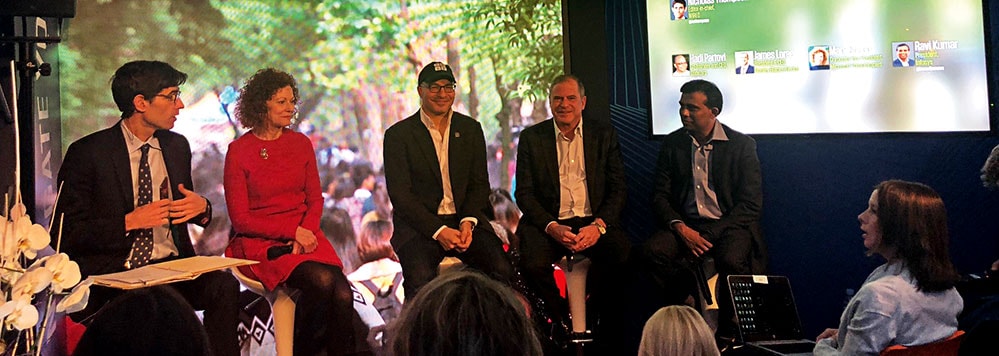
In a session held on January 24 at the World Economic Forum annual event in Davos, moderator Nicholas Thompson, editor-in-chief, WIRED, led a discussion on workforce transformation and how corporations, governments, academia, and individuals need to prepare themselves now for the technological trends that will soon impact workers in every corner of the economy.
An esteemed panel featuring Ravi Kumar S., president and deputy chief operating officer, Infosys; Jim Loree, president and CEO, Stanley Black & Decker; Hadi Partovi, founder and CEO, Code.org; and Mary Snapp, corporate vice president, Microsoft Philanthropies, discussed the workforce changes they see playing out inside their own companies, how they’re developing unique ways to encourage a continuous learning model with their employees, and what academics and educational systems can do to address the need for these new skills in the future.
The Learning Continuum
Ravi Kumar S. opened the discussion by referring to a recent PwC survey that showed scarcity of talent is one of the most significant headwinds that firms face as the digital landscape continues to expand. He said he sees several tectonic shifts in the nature of work, ongoing learning, and how firms need to start preparing themselves now for the reskilling efforts that will be needed to ensure there’s no disruption in operations. The most important shift will be in the current relationship we have between education and work.
“The current way education and work is set is a straight line. You finish higher education, and then you go to work. And that’s how the system was built. I think the future is going to be a continuum. You need to build and apply skills on an ongoing basis, and they’re going to change on a regular basis,” he continued.
Ravi added that it’s also going to be important for professionals to develop cross-functional skills. Firms embracing digital transformation will move from focusing solely on employee STEM skills to incorporating liberal arts and design skills that bring deeper critical thinking and creativity. It is a shift in mindset from being a problem-solver to a problem finder.
At the heart of these changes is going to be a fundamental shift in how organizations are structured, Ravi said. As we grow more accustomed to humans and bots working together, the types of skills that need to evolve will become more apparent. And the responsibility for reskilling workers will then fall on the employer and employee working in tandem instead of just the one or the other, since the new framework operates in a continuum.
Digital’s Impact on the Blue Collar Workforce
As corporations begin the process of workforce transformation by embracing the learning continuum and developing plans to reskill large sections of their workforce, they also have to consider how these digital skills will also transform the jobs of their more physical labor-oriented blue collar workers.
Jim Loree is the president and CEO of Stanley Black & Decker, which is in the business of making products for the world’s blue collar workforce. He said that there’s a misplaced notion that the digital transformation will largely be relegated to the world of the office workers and the people who work directly with technology on a day-to-day basis.
However, he’s already seeing the impact of digital disruption playing out across his factories and supply chain. “We’re going from gritty grease under the fingernails kinds of jobs, to literally, hourly workers who will sit in control rooms,” Loree said. It’s a little bit of an extreme vision, he said, but the technicians of the world are going to become heroes. They’re going to have to become the people who are able to do the work in these control rooms. He shared the story of a 42-year-old technician he met recently at a local community college. The technician had recently gone back to school to get a more technology-oriented degree. The technician told Loree that he feared he would become obsolete, and that by completing this new degree, he had regained his confidence and broadened the skills he needed.
“You could see the bounce in his step and the value that he felt that he could contribute. That’s just a microcosm of what’s to come,” Loree said.
Loree echoed Ravi’s sentiments when he agreed the responsibility to provide these types of expanded education opportunities will lay with the employers. There’s going to be a war for skills, and companies will have to compete on their ability to deliver those skills to their people, he said. Stanley Black & Decker is addressing this issue by collaborating with local factories, governments, and community colleges to determine what the skills of tomorrow entail and find creative solutions to incorporate the teaching of those skills into community college curriculums.
“I think the most important thing that we all have to keep in mind about this is that the human element is probably more important than the technical element,” Loree said. “I think the success of this ultimately comes down to how well society—a combination of companies, governments, and academia—deals with this aspect. Can we really understand the human element and bring solutions to the table?”
Shift in the Focus of Education
Hadi Partovi, founder of Code.org, has devoted his career to bring technology solutions to the public. Code.org’s mission is to expand computer science education not only at the community college and university levels, but at primary and secondary school as well. While we don’t know exactly what the jobs of the future will entail, we do know that the skills needed to perform them are going to be increasingly digital in nature, Partovi said. Whether it’s computer programming, data science, machine learning, robotics, or cybersecurity, there’s no question that every company will need people with these skills. However, Partovi doesn’t think the current education system is equipped to address these needs.
“While we worry about how we change the education establishment and pathway to become a lifelong learning pathway and who’s going to bear the responsibility, we already have an existing, very well-funded system of public education that spends $10 trillion a year globally,” he said. “But while we’re here talking about rescaling the workforce, our schools are teaching the same curriculum that they were teaching 100 years ago, almost as if this conversation doesn’t even exist. The average school in the world teaches twelve years of math and zero years of computer science.”
Mary Snapp, corporate vice president, Microsoft Philanthropies, echoed Partovi’s sentiments regarding the need to amplify the role of computer science education to the world’s youngest students. There’s the obvious connection to the jobs of tomorrow, she said, but there’s also a broader spectrum of systems logic that computer science teaches. It’s not just the coding aspect of computer science that’s important, but also its connections to critical thinking, creativity, communication, and collaboration. These will be the skills needed in the 21st century as people adapt to the new types of jobs available, she said.
Partovi added that their goal isn’t simply to train an entire generation of people who are coders. It’s to get people of all interests and career paths ready for the digitization that’s coming to every profession and trade.
“The reason to teach computer science isn’t because of coding jobs,” Partovi said. “It’s because future doctors, nurses, lawyers, farmers, and factory workers will all have jobs that are going to be in a more digital world. So it’s not to get a job just as a coder—it’s to be a digital native in a world that’s been disrupted by technology.”
Acknowledgements
Infosys would like to acknowledge the contributions made by each of our esteemed panelists. Their insights and thought leadership are greatly appreciated and helped make the World Economic Forum 2019 a richer experience for all participants.
| Mohit Joshi President, Infosys |
Salil Parekh CEO and Managing Director, Infosys |
| Ravi Kumar S. President and Deputy Chief Operating Officer, Infosys |
Hadi Partovi Founder and CEO, Code.org |
| Jim Loree President and CEO, Stanley Black & Decker |
Hans Ploos van Amstel CFO, Adecco Group |
| Andy Maguire Group COO, HSBC |
Kevin Roose Columnist, The New York Times |
| Miguel Milano President EMEA, Salesforce |
Michael Sabia President and CEO, Caisse de dépôt du Québec |
| Illah Narbaksh Professor of Robotics, Carnegie Mellon University |
Erik Schatzker Editor-at-Large for Bloomberg TV |
| Nandan M. Nilekani Chairman, Infosys |
Mary Snapp Corporate Vice President, Microsoft Philanthropies |
| Derek O’Halloran Head, Future of Digital Economy and Society for the World Economic Forum |
Kevin Sneader Global Managing Partner, McKinsey & Company |
| Nicholas Thompson Editor-in-Chief, WIRED |
About Infosys Knowledge Institute
The Infosys Knowledge Institute helps industry leaders develop a deeper understanding of business and technology trends through compelling thought leadership. Our researchers and subject matter experts provide a fact base that aids decision making on critical business and technology issues.
To view our research, visit Infosys Knowledge Institute at infosys.com/IKI
